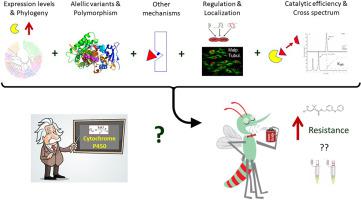当前位置:
X-MOL 学术
›
Pestic. Biochem. Phys.
›
论文详情
Our official English website, www.x-mol.net, welcomes your
feedback! (Note: you will need to create a separate account there.)
Cytochrome P450-based metabolic insecticide resistance in Anopheles and Aedes mosquito vectors: Muddying the waters
Pesticide Biochemistry and Physiology ( IF 4.2 ) Pub Date : 2020-11-01 , DOI: 10.1016/j.pestbp.2020.104666 John Vontas , Eva Katsavou , Konstantinos Mavridis
Pesticide Biochemistry and Physiology ( IF 4.2 ) Pub Date : 2020-11-01 , DOI: 10.1016/j.pestbp.2020.104666 John Vontas , Eva Katsavou , Konstantinos Mavridis

|
Despite the substantial progress achieved in the characterization of cytochrome P450 (CYP) -based resistance mechanisms in mosquitoes, a number of questions remain unanswered. These include: (i) the regulation and physiology of resistance conferring CYPs; (ii) the actual contribution of CYPs in resistance alone or in combination with other detoxification partners or other resistance mechanisms; (iii) the association between overexpression levels and allelic variation, with the catalytic activity and the intensity of resistance and (iv) the true value of molecular diagnostics targeting CYP markers, for driving decision making in the frame of Insecticide Resistance Management applications. Furthermore, the translation of CYP - based insecticide resistance research in mosquitoes into practical applications, is being developed, but it is not fully exploited, as yet. Examples include the production of high throughput platforms for screening the liability (stability) or inhibition potential of novel insecticidal leads and synergists (add-ons), as well as the exploration of the negative cross resistance concept (i.e. detoxification of certain insecticides, but activation of others pro-insecticides). The goal of this review is to critically summarise the current knowledge and the gaps of the CYP-based metabolic insecticide resistance in Anopheles and Aedes mosquito vectors. The progress and limitations of the protein and the reverse/forward genetic approaches, the understanding and importance of molecular and physiological aspects, as well as the current and future exploitation routes of CYP research are discussed.
中文翻译:

按蚊和伊蚊媒介中基于细胞色素 P450 的代谢杀虫剂抗性:弄脏水
尽管在描述蚊子基于细胞色素 P450 (CYP) 的抗性机制方面取得了实质性进展,但仍有许多问题没有得到解答。这些包括: (i) 赋予 CYP 抗性的调节和生理学;(ii) CYPs 单独或与其他解毒伙伴或其他抗性机制联合对抗性的实际贡献;(iii) 过表达水平和等位基因变异、催化活性和抗性强度之间的关联,以及 (iv) 针对 CYP 标记的分子诊断的真正价值,用于在杀虫剂抗性管理应用框架内推动决策。此外,正在开发将基于 CYP 的蚊子杀虫剂抗性研究转化为实际应用,但它还没有被充分利用。例子包括用于筛选新杀虫先导物和增效剂(附加物)的易感性(稳定性)或抑制潜力的高通量平台的生产,以及负交叉抗性概念的探索(即某些杀虫剂的解毒,但激活其他亲杀虫剂)。本综述的目的是批判性地总结当前知识和基于 CYP 的代谢杀虫剂在按蚊和伊蚊载体中的差距。讨论了蛋白质和反向/正向遗传方法的进展和局限性,分子和生理方面的理解和重要性,以及 CYP 研究的当前和未来开发路线。例子包括用于筛选新杀虫先导物和增效剂(附加物)的易感性(稳定性)或抑制潜力的高通量平台的生产,以及负交叉抗性概念的探索(即某些杀虫剂的解毒,但激活其他亲杀虫剂)。本综述的目的是批判性地总结当前知识和基于 CYP 的代谢杀虫剂在按蚊和伊蚊载体中的差距。讨论了蛋白质和反向/正向遗传方法的进展和局限性,分子和生理方面的理解和重要性,以及 CYP 研究的当前和未来开发路线。例子包括用于筛选新杀虫先导物和增效剂(附加物)的易感性(稳定性)或抑制潜力的高通量平台的生产,以及负交叉抗性概念的探索(即某些杀虫剂的解毒,但激活其他亲杀虫剂)。本综述的目的是批判性地总结当前知识和基于 CYP 的代谢杀虫剂在按蚊和伊蚊载体中的差距。讨论了蛋白质和反向/正向遗传方法的进展和局限性,分子和生理方面的理解和重要性,以及 CYP 研究的当前和未来开发路线。
更新日期:2020-11-01
中文翻译:

按蚊和伊蚊媒介中基于细胞色素 P450 的代谢杀虫剂抗性:弄脏水
尽管在描述蚊子基于细胞色素 P450 (CYP) 的抗性机制方面取得了实质性进展,但仍有许多问题没有得到解答。这些包括: (i) 赋予 CYP 抗性的调节和生理学;(ii) CYPs 单独或与其他解毒伙伴或其他抗性机制联合对抗性的实际贡献;(iii) 过表达水平和等位基因变异、催化活性和抗性强度之间的关联,以及 (iv) 针对 CYP 标记的分子诊断的真正价值,用于在杀虫剂抗性管理应用框架内推动决策。此外,正在开发将基于 CYP 的蚊子杀虫剂抗性研究转化为实际应用,但它还没有被充分利用。例子包括用于筛选新杀虫先导物和增效剂(附加物)的易感性(稳定性)或抑制潜力的高通量平台的生产,以及负交叉抗性概念的探索(即某些杀虫剂的解毒,但激活其他亲杀虫剂)。本综述的目的是批判性地总结当前知识和基于 CYP 的代谢杀虫剂在按蚊和伊蚊载体中的差距。讨论了蛋白质和反向/正向遗传方法的进展和局限性,分子和生理方面的理解和重要性,以及 CYP 研究的当前和未来开发路线。例子包括用于筛选新杀虫先导物和增效剂(附加物)的易感性(稳定性)或抑制潜力的高通量平台的生产,以及负交叉抗性概念的探索(即某些杀虫剂的解毒,但激活其他亲杀虫剂)。本综述的目的是批判性地总结当前知识和基于 CYP 的代谢杀虫剂在按蚊和伊蚊载体中的差距。讨论了蛋白质和反向/正向遗传方法的进展和局限性,分子和生理方面的理解和重要性,以及 CYP 研究的当前和未来开发路线。例子包括用于筛选新杀虫先导物和增效剂(附加物)的易感性(稳定性)或抑制潜力的高通量平台的生产,以及负交叉抗性概念的探索(即某些杀虫剂的解毒,但激活其他亲杀虫剂)。本综述的目的是批判性地总结当前知识和基于 CYP 的代谢杀虫剂在按蚊和伊蚊载体中的差距。讨论了蛋白质和反向/正向遗传方法的进展和局限性,分子和生理方面的理解和重要性,以及 CYP 研究的当前和未来开发路线。











































 京公网安备 11010802027423号
京公网安备 11010802027423号